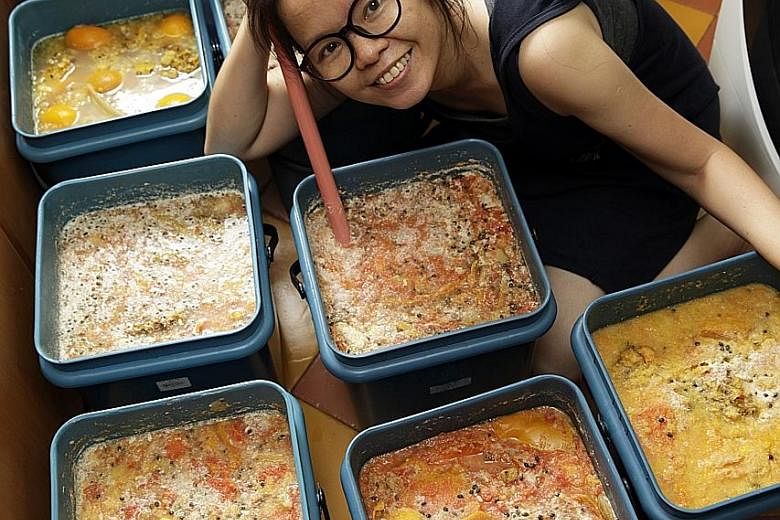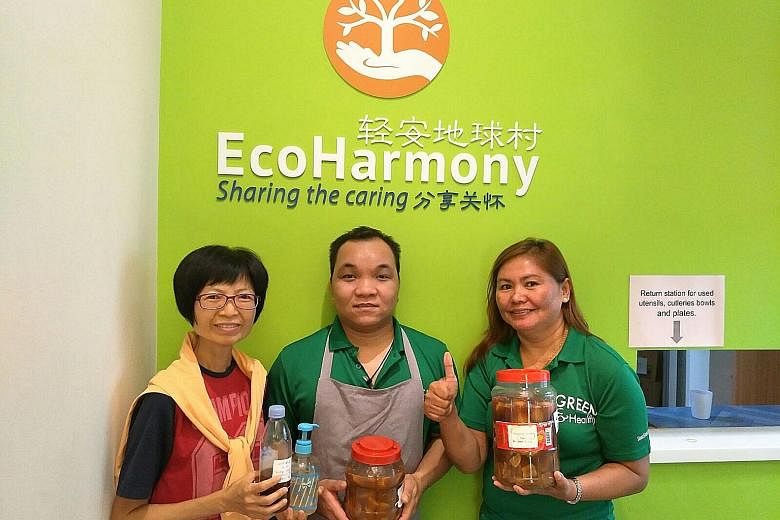Ms Ng Wai Sen, 42, was once so thrilled to come across a basket full of discarded fruit peels at a fruit stall that she shouted with joy.
The volunteer with various environmental and non-profit groups recalls: "The worker at the stall asked me jokingly if I had found gold."
Since early this year, she has been keeping fruit waste from her kitchen as well as collecting them from fruit and juice stalls in her neighbourhood in Marine Parade.
She uses them to make "garbage enzymes" for washing dishes, fruits and vegetables; mopping the floor; and fertilising her plants.
She also collects unwanted 5-litre plastic containers from hawker stalls and gives them to friends and strangers to encourage them to make the enzymes.
She explains: "Commercial products may contain chemicals which are harmful to the environment. Besides, it costs very little to make garbage enzymes and you are also helping to 'upcycle' food waste."
To make these solutions, she adds sugar and water to a mixture of fruit peels - from fruits such as pineapple, papaya, pomelo, orange and lemon - and keeps the mixture in airtight plastic containers. She prefers fruit peels over vegetable scraps as she finds them more fragrant.
After about three months, she filters the residue and gets the garbage enzymes - a clear, dark brown liquid, which has a sour smell like vinegar.
She is among a growing group of people here who convert kitchen waste to garbage enzymes for cleaning and other purposes.
-

-
HOW TO MAKE GARBAGE ENZYMES
Ms Ng Wai Sen, 42, a volunteer with various environmental groups, started making her own garbage enzymes this year. Here are some of her tips.
INGREDIENTS
1. Fruit waste, including peels, seeds and flesh. Do not use hard parts such as durian husks and mango seeds.
2. Sugar (white or brown)
3. Water (can be recycled water from washing rice, fruits or vegetables)
4. An airtight plastic container. Store the container in a cool and dry place away from direct sunlight.
METHOD
1. Make 16 equal folds on a piece of paper. Unfold the paper and put it against the container. Use a marker to mark 16 lines on the container that correspond to the folds. Then add three parts fruit peel or juiced fruit residue, one part sugar and 10 parts water.
2. Give the mixture a good shake and tighten the lid.
3. In the first month, stir every day or every other day to release fermented carbon gas. In the second month, stir once a week and, in the third month, once in two weeks. If your container has a small opening, try to release the gas daily in the first month or tie a plastic bag at the opening with rubber band to allow gas to enter it.
4. The mixture should be ready in three months. Use a sieve or pillow case to filter the residue. -
HOW TO USE THE ENZYMES
1. For mopping the floor and general cleaning, Ms Ng pours one mineral bottle capful of the enzyme into 1 to 2 litres of water.
2. For washing fruits and vegetables, she pours one mineral bottle capful of enzymes into one salad bowl.
3. To water plants once a week, she pours one capful to 1 litre of water.
4. To wash dishes, she uses one part garbage enzymes to one part dishwashing liquid.
Enzymes good as pesticide
For technology innovation manager Audrey Ho, 37, it was her mother who started making garbage enzymes out of pineapple peels in 2012, following instructions on YouTube videos. She used them to clean the floor and toilets and to wash fruits and vegetables.
After her mother died in 2014, Dr Ho took over the two plastic containers of fermenting peels that she left behind and continued to make enzymes out of them. "It was a way to remember her," she says.
Her interest grew from there. She has since experimented with converting other fruit peels into enzymes and has extended their use to dishwashing. She says: "I just want to do my bit to reduce food waste."
Kampung Senang, an eco- conscious charity and education foundation, is probably one of the earliest groups here to start making garbage enzymes. Since it was founded in 1999, its staff members have been making garbage enzymes out of fruit and vegetable scraps. These are now used for mopping the floor and washing hands in toilets.
At its Eco-harmony cafe, garbage enzymes are used for washing dishes. The charity also runs garbage enzyme-making courses for the public.
Its founder Joyce Lye, 65, says that garbage enzymes are non- toxic and better for both the environment and humans.
Professor William Chen, director of Food Science & Technology Programme at the Nanyang Technological University, agrees, adding that "being biological and biodegradable, garbage enzymes are presumably better for the environment".
However, he says that the term is somewhat of a misnomer. "It actually refers to a product of anaerobic fermentation (fermentation without oxygen) by micro-organisms rather than enzymes per se."
The micro-organisms, such as yeast or bacteria, need carbon sources such as sugars for their growth.
The end product is either alcohol, acetic acid or both. Both compounds are known for their cleaning and anti-microbial properties. Acetic acid is the main ingredient in vinegar.
Due to their ability to fight bacteria and fungi, they can also be used as a pesticide or an air purifier, says Prof Chen.
Research scientist Miao Huang from Temasek Polytechnic's School of Applied Science says that garbage enzymes can also be used as fertilisers.
She says: "In our laboratory, we were able to use garbage enzymes to grow algae cells without any additional nutrients. This suggests that they can support plant growth."
She is planning to study the effectiveness of garbage enzymes as fertilisers.
But while garbage enzymes are environment-friendly, it is not known what their optimal amount or concentration for cleaning is.
Dr Chen advises users to test the solution on small areas first.
"If the concentration is too diluted or not fermented enough, it might not be effective. If it is overly fermented and concentrated, it could stain or damage certain floors and furniture," he says.
Garbage enzyme users, however, say they do not face this problem.
Ms Ng says she got the dilution ratio from online resources as well as from a Facebook group she joined.
"Maybe because the 'enzymes' are diluted, they do not leave a residual colour. Nor do they give a sticky feeling or attract ants. They do not leave behind a vinegar-ish smell after cleaning and washing either."
Not only does she find garbage enzymes as effective as the commercial cleaning agents she used previously, but she also says they are effective as a pesticide and fertiliser, as the experts say.
"My plants used to attract aphids, but they no longer do so after I started using garbage enzymes."
Correction note: An earlier version of the story left out "one part sugar" in the first step of making garbage enzymes. We are sorry for the error.


